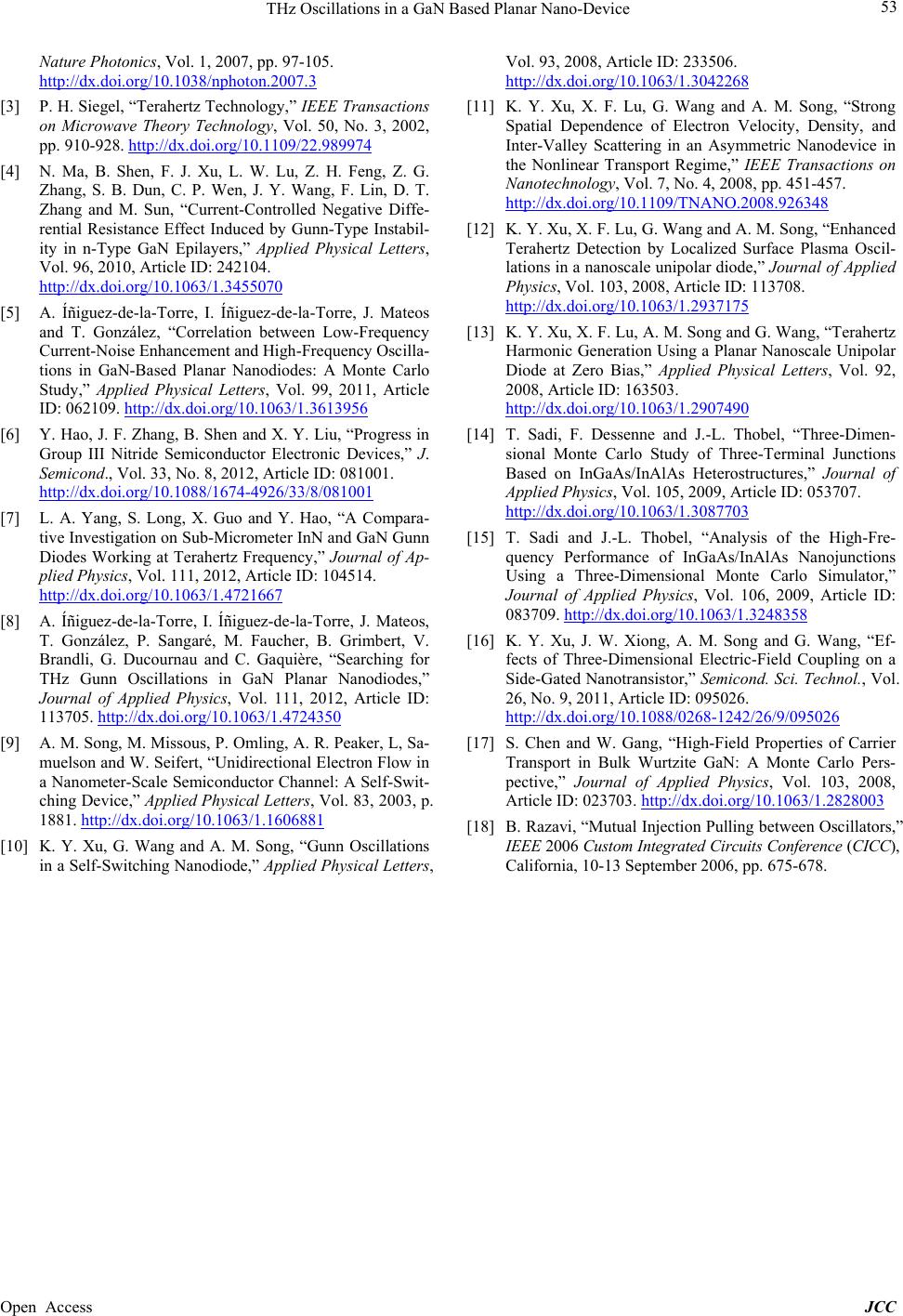
THz Oscillations in a GaN Based Planar Nano-Device
Open Access JCC
Nature Photonics, Vol. 1, 2007, pp. 97-105.
http://dx.doi.org/10.1038/nphoton.2007.3
[3] P. H. Siegel, “Terahertz Technology,” IEEE Transactions
on Microwave Theory Technology, Vol. 50, No. 3, 2002,
pp. 910-928. http://dx.doi.org/10.1109/22.989974
[4] N. Ma, B. Shen, F. J. Xu, L. W. Lu, Z. H. Feng, Z. G.
Zhang, S. B. Dun, C. P. Wen, J. Y. Wang, F. Lin, D. T.
Zhang and M. Sun, “Current-Controlled Negative Diffe-
rential Resistance Effect Induced by Gunn-Type Instabil-
ity in n-Type GaN Epilayers,” Applied Physical Letters,
Vol. 96, 2010, Article ID: 242104.
http://dx.doi.org/10.1063/1.3455070
[5] A. Íñiguez-de-la-Torre, I. Íñiguez-de-la-Torre, J. Mateos
and T. González, “Correlation between Low-Frequency
Current-Noise Enhancement and High-Frequency Oscilla-
tions in GaN-Based Planar Nanodiodes: A Monte Carlo
Study,” Applied Physical Letters, Vol. 99, 2011, Article
ID: 062109. http://dx.doi.org/10.1063/1.3613956
[6] Y. Hao, J. F. Zhang, B. Shen and X. Y. Liu, “Progress in
Group III Nitride Semiconductor Electronic Devices,” J.
Semicond., Vol. 33, No. 8, 2012, Article ID: 081001.
http://dx.doi.org/10.1088/1674-4926/33/8/081001
[7] L. A. Yang, S. Long, X. Guo and Y. Hao, “A Compara-
tive Investigation on Sub-Micrometer InN and GaN Gunn
Diodes Working at Terahertz Frequency,” Journal of Ap-
plied Physics, Vol. 111, 2012, Article ID: 104514.
http://dx.doi.org/10.1063/1.4721667
[8] A. Íñiguez-de-la-Torre, I. Íñiguez-de-la-Torre, J. Mateos,
T. González, P. Sangaré, M. Faucher, B. Grimbert, V.
Brandli, G. Ducournau and C. Gaquière, “Searching for
THz Gunn Oscillations in GaN Planar Nanodiodes,”
Journal of Applied Physics, Vol. 111, 2012, Article ID:
113705. http://dx.doi.org/10.1063/1.4724350
[9] A. M. Song, M. Missous, P. Omli ng, A. R. Peaker, L, Sa -
muelson and W. Seifert, “Unidirectional Electron Flow in
a Nanometer-Scale Semiconductor Channel: A Sel f-Swit-
ching Device,” Applied Physical Letters, Vol. 83, 2003, p.
1881. http://dx.doi.org/10.1063/1.1606881
[10] K. Y. Xu, G. Wang and A. M. Song, “Gunn Oscillations
in a Self-Switching Nanodiode,” Applied Physical Letters,
Vol. 93, 2008, Article ID: 233506.
http://dx.doi.org/10.1063/1.3042268
[11] K. Y. Xu, X. F. Lu, G. Wang and A. M. Song, “Strong
Spatial Dependence of Electron Velocity, Density, and
Inter-Valley Scattering in an Asymmetric Nanodevice in
the Nonlinear Transport Regime,” IEEE Transactions on
Nanotechnology, Vol. 7, No. 4, 2008, pp. 451-457.
http://dx.doi.org/10.1109/TNANO.2008.926348
[12] K. Y. Xu, X. F. Lu, G. Wang and A. M. Song, “Enhanced
Terahertz Detection by Localized Surface Plasma Oscil-
lations in a nanoscale unipolar diode,” Journal of Applied
Physics, Vol. 103, 2008, Article ID: 113708.
http://dx.doi.org/10.1063/1.2937175
[13] K. Y. Xu, X. F. Lu, A. M. Song and G. Wang, “Terahertz
Harmonic Generation Using a Planar Nanoscale Unipolar
Diode at Zero Bias,” Applied Physical Letters, Vol. 92,
2008, Article ID: 163503.
http://dx.doi.org/10.1063/1.2907490
[14] T. Sadi, F. Dessenne and J.-L. Thobel, “Three-Dimen-
sional Monte Carlo Study of Three-Terminal Junctions
Based on InGaAs/InAlAs Heterostructures,” Journal of
Applied Physics, Vol. 105, 2009, Article ID: 053707.
http://dx.doi.org/10.1063/1.3087703
[15] T. Sadi and J.-L. Thobel, “Analysis of the High-Fre-
quency Performance of InGaAs/InAlAs Nanojunctions
Using a Three-Dimensional Monte Carlo Simulator,”
Journal of Applied Physics, Vol. 106, 2009, Article ID:
083709. http://dx.doi.org/10.1063/1.3248358
[16] K. Y. Xu, J. W. Xiong, A. M. Song and G. Wang, “Ef-
fects of Three-Dimensional Electric-Field Coupling on a
Side-Gated Nanotransistor,” Semicond. Sci. Technol., Vol.
26, No. 9, 2011, Article ID: 095026.
http://dx.doi.org/10.1088/0268-1242/26/9/095026
[17] S. Chen and W. Gang, “High-Field Properties of Carrier
Transport in Bulk Wurtzite GaN: A Monte Carlo Pers-
pective,” Journal of Applied Physics, Vol. 103, 2008,
Article ID: 023703. http://dx.doi.org/10.1063/1.2828003
[18] B. Razavi, “Mutual Injection Pulling between Oscillators,”
IEEE 2006 Custom Int egrated Circuits Conference (CICC),
California, 10-13 September 2006, pp. 675-678.